Great White Shark - Frequently Asked Questions
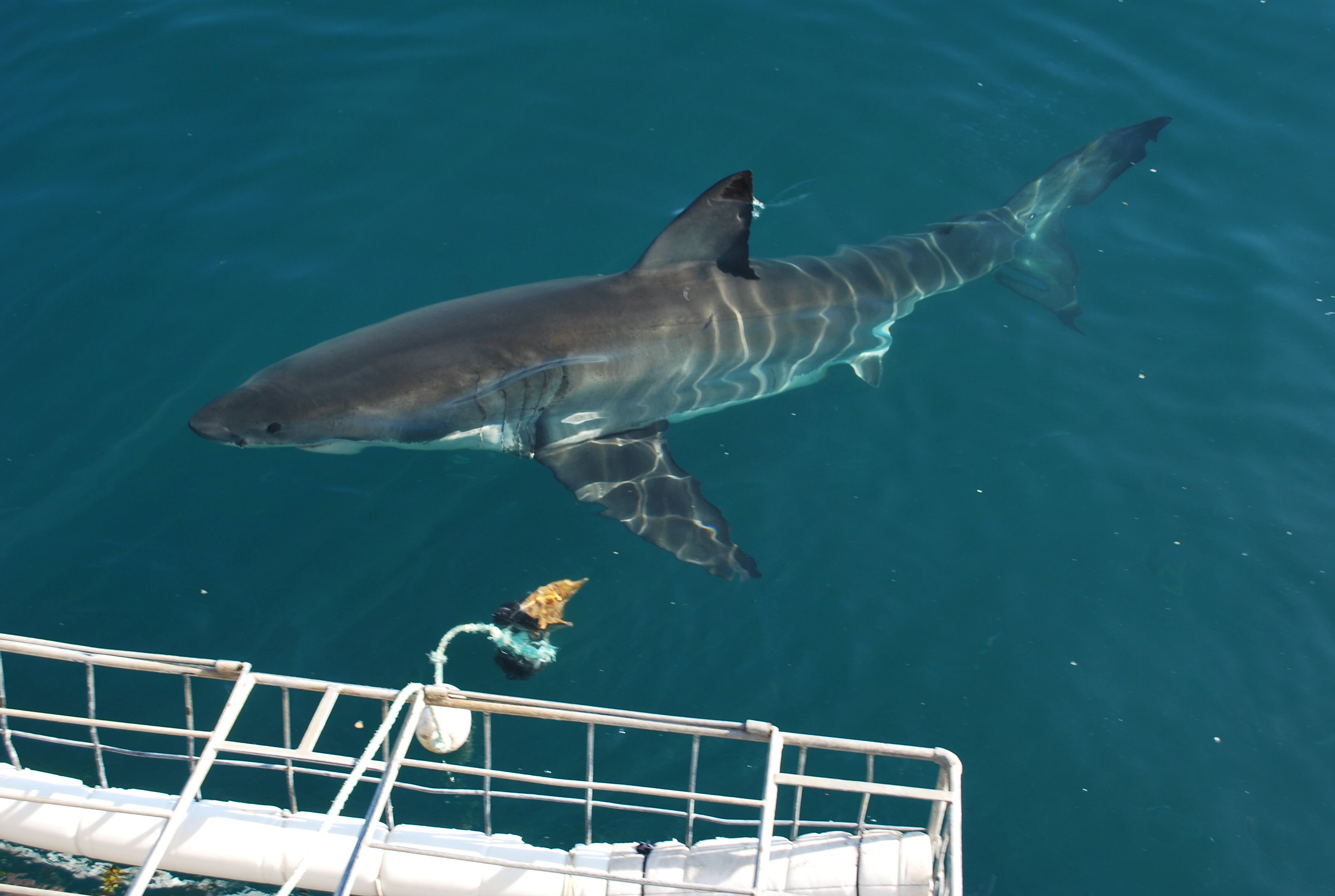
Image: Great white shark swimming past a cage in Gansbaai (by Saxon Lodge Gansbaai)
Why are they called great white sharks?
Their size and white bellies, as well as their awesomeness, lead to the name because they are not only big, they are a GREAT species! Great white sharks grow to an average of 15 feet (4,6 m) in length, though specimens exceeding 20 feet (6 m) and weighing up to 5,000 pounds (2,268 kg) have been recorded. The biggest known great white ever caught was a mammoth 20 feet caught off Prince Edward Island in 1993. Their upper bodies are shades of slate-grey, blue and black to blend with the rocky coastal seafloor, but their underbellies are pure white. They are stately and streamlined torpedo-shaped swimmers with powerful tails that can propel them through the water at speeds of up to 15 miles (24 km) per hour. They can even leave the water completely, breaching like whales when attacking prey from underneath.
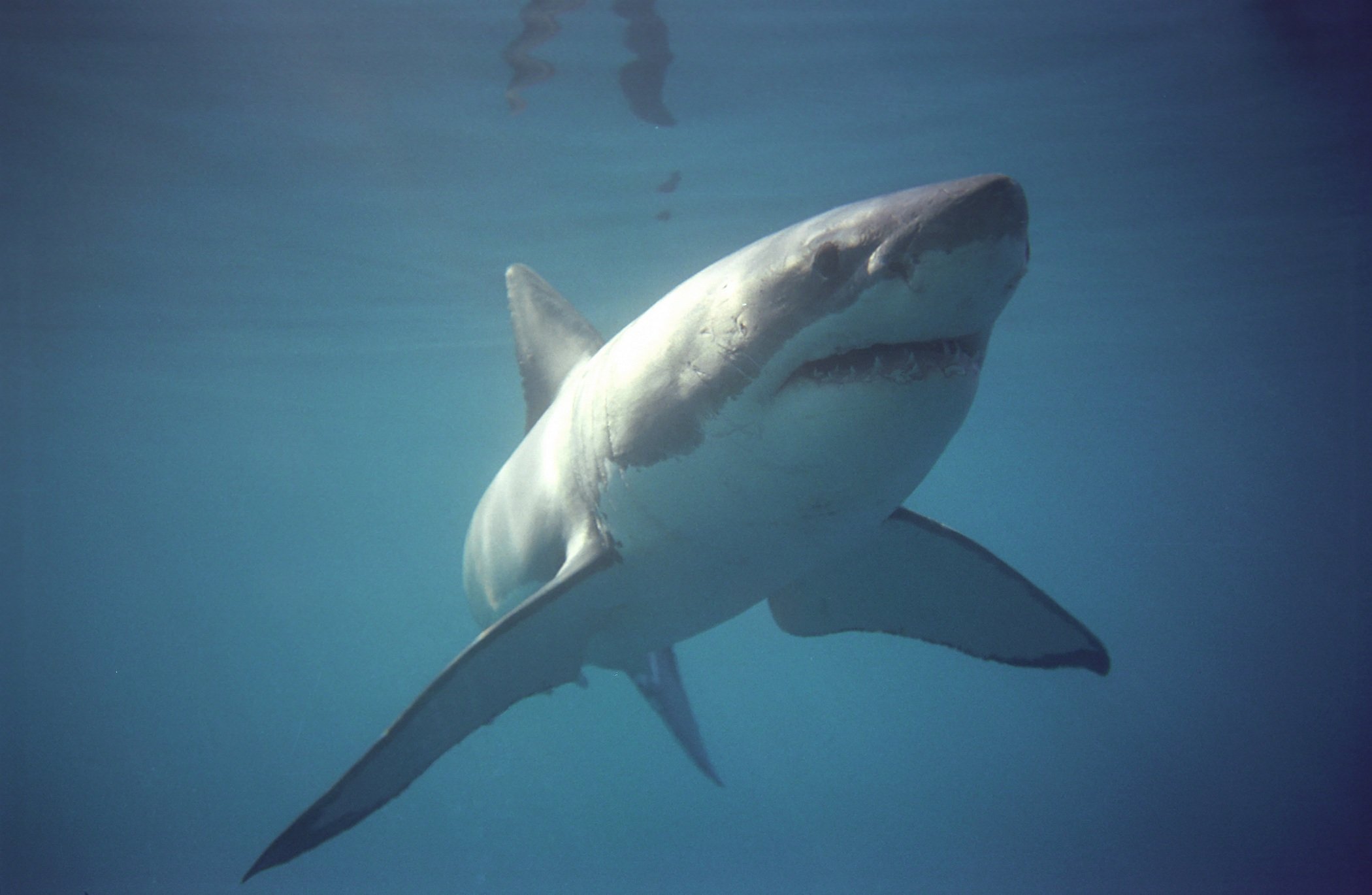
Image: Notice the great white sharks white underneath and dark top half.
Why do great white sharks attack humans?
Fact is, they DO NOT! They are merely curious and "sample biting" and have no intention to harm or kill humans, as human flesh is not on their menu! More than 70% of known victims of great white shark "bites" survive because the shark realizes it has made a mistake and doesn’t finish off the prey. Ironically, sharks have much more reason to fear people, seeing that up to 100 million sharks are killed by people every year. The chance of being killed by a shark is one in 300 million - the chance of being killed by aeroplane parts falling from the sky is one in 10 million! Of the more than 350 shark species, only four species are a threat to people IF we invade their territory. They are the great whites, tiger sharks, bull sharks and the oceanic white-tip.
What do great white sharks eat?
Sharks have a diverse, balanced diet ranging from fish to mammals. Their main prey includes sea lions, seals, small toothed whales, and even sea turtles, and carrion. Young great white sharks even eat leopard sharks. Sharks do not chew their food, they swallow it whole and if it is too big, they tear it into chunks with their special teeth. A great white shark is capable of eating sea lions whole. Baby sharks are born with sharp teeth and the ability to hunt right from the start. great whites have up to 300 serrated, triangular teeth arranged in several rows and it is believed that they may use and lose more than 30 000 teeth during their lifetime. The new teeth are larger than the ones they replace and some sharks even produce different shaped teeth as they grow older. Shark teeth have been used as weapons and tools for many centuries and today fossilized teeth of between 20 - 200 million years old are also sought-after keepsakes and jewellery items. (It is illegal to sell or to be in possession of any recent white shark products in South Africa.) The jaws of bigger sharks are about twice as powerful as the jaws of a lion.
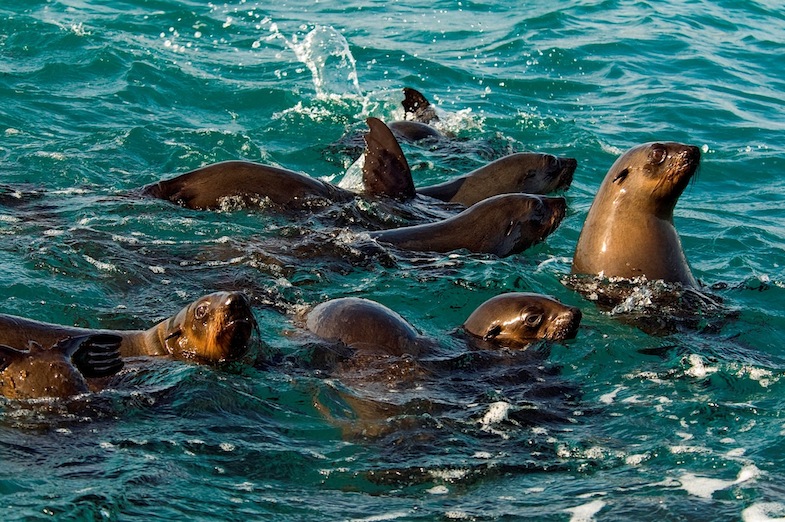
Image: Seals, the great white sharks top choice to hunt.
Do humans eat great white sharks?
The meat of great whites has very high mercury levels and is thus not recommended for human consumption, but dried shark meat (shark biltong) has become a popular treat. Shark meat is also often sold as rock salmon, rock eel, huss or flake - simply because it sounds more appealing than shark meat. Extracts from a shark’s gall bladder are used in the treatment of both eye cataracts and acne. During the 17th century in France, the shark brain was eaten to ease the pain of childbirth. Today, the capacity of dried shark brain to relieve pain is widely recognised. Sharkskin was also used on the handles of swords so that warriors’ hands would not slip when they became sweaty. A large amount of oil in the shark's liver that helps them to float was once used to make vitamin A pills and to light lamps. In certain places, like the Solomon and Fiji islands, eating shark flesh is forbidden. The dermal denticles that cover sharks' skin are so tough and hard that before the invention of sandpaper, shark skin was used to polish wood. The great white shark has an enormous liver that can weigh up to 24% of its entire weight.
Do they go into a "feeding frenzy" when they smell blood?
No, the splashing and tail-slapping may just look like a "frenzy" to an ignorant onlooker. Great white sharks do not fight over food. The bigger or more dominant animal normally takes control of the area. It has been observed that when feeding on whale carcasses the sharks have a pecking order where one would come in and feed and only when it leaves, will the next one move in to feed. When there is only enough food for one, they have a tail-slapping contest. The sharks swim past each other, each slapping the surface of the water with their tails, and often directing the spray towards the other shark. The one who gets the meal is the shark that delivers the most tail slaps!
What are the great white sharks eating habits?
Unlike humans, great white sharks do not over-indulge or eat out of habit. They hunt and eat when they are hungry and when food is scarce, they can go without food for a long time because their bodies are able to store nutrients, much like a camel. Scientists estimate that after a big meal, a great white shark can last up to three months before needing another one. Great whites often have scratches and scars on their snouts that resulted from their prey fighting back.
How many great white sharks are there and where does one find them?
Great whites are private, elusive apex predators that gracefully cruise the Seven Seas and can easily cover distances of up to 20 000 km in 9 months. They migrate between all the continents, except Antarctica. Because of the vast distances they cover and their elusive nature, it is difficult to keep track of their migrating patterns and habits. In 2018, some scientists believe there are only about 1 000 great whites left on the planet, while others estimate their numbers at anything between 2 000 and 10 000. In a recent population study done at the University of Stellenbosch, only 370 individual animals were identified over a two year period. Fact is, they are fast becoming extinct due to overexploitation, accidental catching in gill nets and habitat degradation. This has created a catch 22 situation for many species of shark which utilize inshore areas as nursery grounds. They are listed as an endangered species.
Do great white sharks smell, hear or see their prey?
All of that and more. Sharks, like most animal species, have an intricate sensory system that makes them much more sensitive to their surroundings than humans. A shark can "hear" a fish in the water from more than a mile away and smell tiny amounts of blood up to 5 km away. Furthermore, the great white sharks developed a great visual system, very much like our own, at distances of 15 metres or less, vision is probably its most dominant sense. Their eyes are 10 times more sensitive to light than that of humans, which enables them to see perfectly in day or night light and to hunt by starlight alone. Contrary to popular belief, the great whites also have a full-colour vision. Although their eyes appear to be black, it is not. The pupil is circular, the iris dark and ringed with a spectral hint of midnight blue. They have no eyelids - they roll the eyeballs back to protect the vital front part of the eye from being scratched. These mammals have an exceptional sense of smell to detect prey and can "smell" one drop of blood in 100 L of water. Their intricate sensory system even enables them to detect the tiny electromagnetic fields generated by animals. The hammerhead shark has the best sense of smell. But apart from these amazing sensory organs, the great white is one of the shark species that rely heavily on vision to provide it information about the world in which it must earn a living.
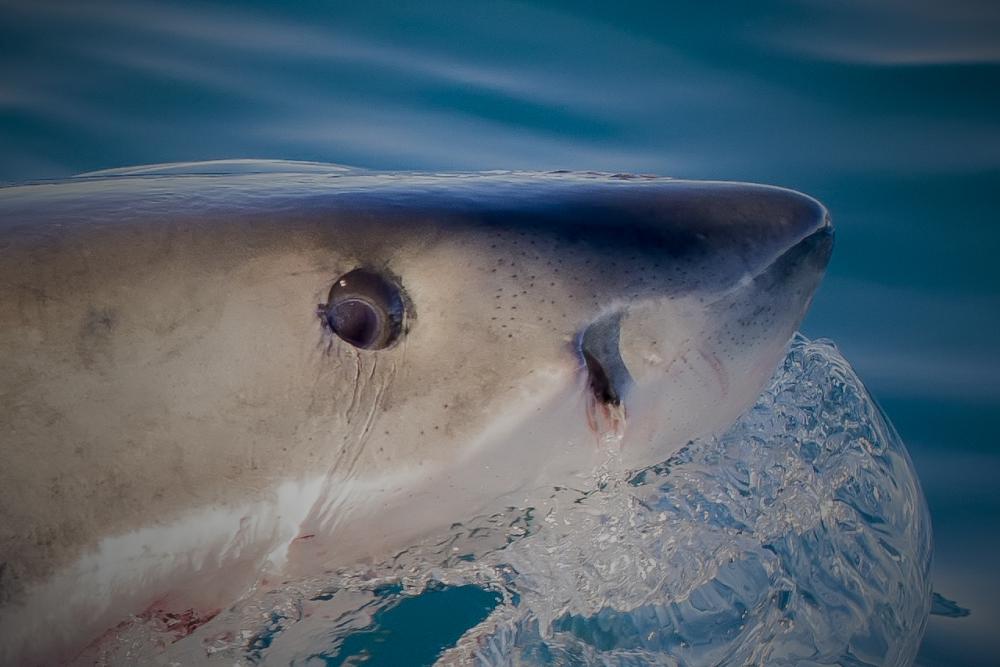
Image: Great white shark eye (by White Shark Projects)
When and where do the great white sharks breed?
At the time of writing this, no one has ever seen a great white shark give birth in the wild. They breed late in life - only when they are at least about 15 years old and have reached a size of 4,5 m in length (females) and 3,6 m (males). When it is time to mate, female sharks release pheromones into the water to help male sharks find them. Most baby sharks that are born live emerge tail first, although a few species are born headfirst. Shark mothers do not feed their babies - they are equipped to survive on their own. Sharks continue growing throughout their lives - their bodies never stop growing and they have an amazing immune system protecting them against illnesses. Their wounds heal quickly and they rarely get tumours.
Who are the enemies of the great white sharks?
Sadly, mankind is the great white shark's only true enemy. They have no natural enemies, although on some rare occasions orcas, better known as killer whales, have been recorded killing a great white. The latter is no match for an orca in a fight. orcas sometimes hunt in packs, plus they are too fast and strong for even the biggest great whites. Orcas have been known to kill and eat them as well on rare occasions. Commercial and Recreational fishing practices are the biggest threat to all fish species while poaching for the shark teeth trade is also a big killer. In South Africa, there is great concern about the 38 km of shark nets and drum lines placed by the Natal Sharks Board along the east coast that annually kills thousands of great whites and other fish species.
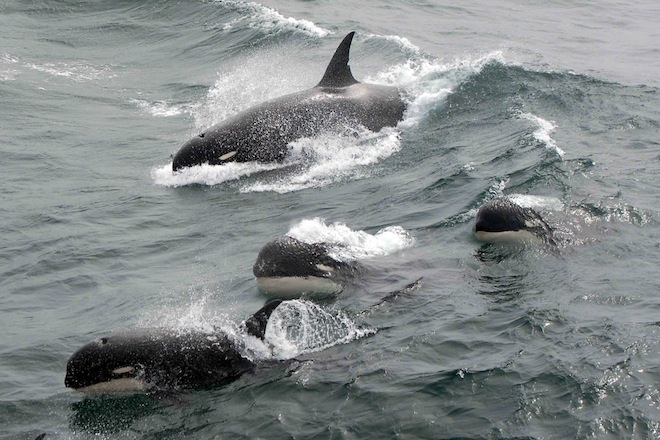
Image: Orcas, the great white shark hunters.
Where do great white sharks from?
Most sharks as we know them today developed about 64 million years ago during the age of the dinosaurs.
The very first ancestors of sharks appeared 200 million years before dinosaurs roamed the earth. Sharks are more related to fish species such as the stingray than to the barracuda. Half of the shark species averages less than a meter long and the females are bigger than the males. Sadly enough, research on the great whites is still relatively new and controversial. Nobody knows how old they get. Because of their extraordinary immune system and self-healing abilities, as well as their slow reproduction rate, it is believed that they have a relatively long life span. At this stage, however, scientists can only estimate their average life expectancy at anything between 35 and 150 years until more research has been done.













